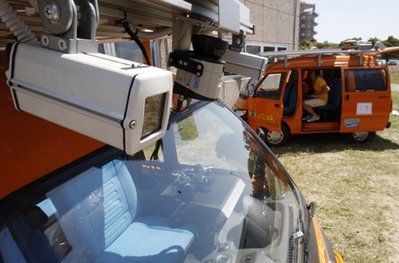Global General
Italy to China in driverless vehicles
(Agencies)
Updated: 2010-07-20 23:00
 |
Large Medium Small |
PARMA, Italy - It's a modern-day version of Marco Polo's journey halfway around the world _ but is anyone at the controls?
 |
|
In this Thursday, July 15, 2010 video cameras are seen on the front of an unmanned electric-powered vehicle as a technician works on another similar vehicle in Parma, Italy. Next week, four electric-powered orange vans depart on what has been conceived as the longest-ever test drive of unmanned vehicles: a 13,000-kilometer (8,000-mile), three-month road trip from Italy to China.. [Agencies] |
A team of Italian engineers on Tuesday launched what has been billed as the longest-ever test drive of driverless vehicles: a 13,000-kilometer (8,000-mile), three-month road trip from Italy to China, not in search of silk, but to test the limits of future automotive technology.
Two bright orange vehicles, equipped with laser scanners and cameras that work in concert to detect and help avoid obstacles, are to brave the traffic of Moscow, the summer heat of Siberia and the bitter cold of the Gobi desert before the planned arrival in Shanghai at the end of October.
"What we are trying to do is stress our systems and see if they can work in a real environment, with real weather, real traffic and crazy people who cross the road in front of you and a vehicle that cuts you off," said project leader Alberto Broggi.
|
||||
The driverless vehicle takes cues from the lead van, but will have to respond to any ordinary obstacles or dangers. The two pairs alternate stretches along the route to China.
"We will definitely need some help by humans. It is not possible to have 100 percent driverless. This is why I call it a test, not a demonstration," Broggi said.
Governments have yet to write rules of the road for driverless vehicles, so the team has obtained prior permission from all countries along the route to carry out the experiment. To protect themselves from liability, they are placing one of the technicians in the driver's seat, ready to assume the controls or slam a red shutdown button if necessary.
The technology developed by Vislab, an artificial vision and intelligent systems lab at the University of Parma run by Broggi, might one day allow driverless vehicles to transport goods across Europe.
Analysts say such technology is feasible in the foreseeable future, but some question its utility.

